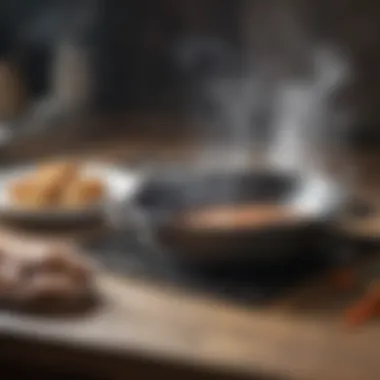The Health Risks of Teflon Cookware: A Detailed Analysis


Intro
Teflon cookware is a ubiquitous presence in modern kitchens, known for its non-stick properties and ease of use. However, growing concerns about the potential health risks associated with Teflon have prompted discussions among health-conscious consumers. This piece aims to explore these issues, particularly the release of toxic fumes during cooking. With foundational details about Teflon’s chemical make-up, evidence from recent research, and an evaluation of healthier cookware alternatives, it offers a thorough examination.
By dissecting the implications of using Teflon-coated cookware, one Hopes to equip readers with the necessary knowledge to make informed choices. It is critical to approach this unfolding narrative with caution, considering both health and environmental impacts that continue to spark debate among experts.
Care Tips
Proper maintenance of cookware can mitigate some potential toxicities associated with usage. Here are several basic care routines:
Daily Care Routines
Handle non-stick pans and pots with care. Always use wooden, silicone, or plastic utensils that prevent scratching the Teflon surface. Never use metal tools, as they can lead to flaking.
Avoid soaking Teflon cookware in hot water when washing. Instead, use a soft sponge and mild dish soap. Proper handling can assure one enjoys Teflon’s convenience without undue risk.
Hygiene and Cleaning Practices
For enhanced durability, it is advised not to use dishwashers for cleaning Teflon cookware. Hand washing preserves the non-stick surface, prolonging its lifespan. Stay away from fine scouring pads, and instead opt for gentle cleaning solutions.
Avoid High Heat
Using Teflon-coated cookware at excessive temperatures can result in fumes that pose risks. Keeping stovetop heat balanced and lowering the flame can minimize such fume emissions. If potential burning of the cookware occurs, one risks exposure to toxic gases.
Generally, maintaining the 500-degree Fahrenheit limit is advisable for non-stick materials.
Replacement Consideration
If any sign of deterioration appears—a flaking surface or excessive scratching—it is best to replace the cookware immediately. Investing in high-quality alternatives may seem steep initially but will promote safer cooking methods over time.
This section just scratches the surface regarding care practices. A closer look will now turn to the chloride compounds within Teflon and assess their broader health implications.
Understanding Teflon and Its Composition
Teflon is a key material in cookware, recognized for its non-stick properties and durability. Understanding Teflon becomes crucial when examining its potential health impacts, especially regarding its chemical composition and how it may interact with food.
What is Teflon?
Teflon is the brand name for polytetrafluoroethylene, a synthetic polymer discovered by accident in 1938. This material is praised for its myriad of properties, chiefly its ability to repel substances. It has found widespread use in various applications, from industrial seals to household cookware.
In the context of cookware, Teflon is valued for its incredible non-stick capabilities. This feature means that food does not easily adhere to the surface, allowing for easier cooking and cleaning. However, many may not fully appreciate the complexities behind this seemingly simple feature, primarily its implications for health and safety.
Chemical Properties of Polytetrafluoroethylene
Polytetrafluoroethylene has a high resistance to heat, chemicals, and electrical conductivity. Its molecular structure consists of a carbon backbone enveloped in fluorine atoms. This configuration generates a substance that resists corrosion and degradation.
Careful consideration of chemical properties is key. While Teflon provides advantages in durability and usage, the very properties that make it effective also raise questions. Potential safety concerns, especially when overheated, show that Teflon may emit toxic fumes. Understanding the chemical nature of Teflon provides a foundation for investigating these health implications.
The knowledge of Teflon's chemical behavior is essential for consumers seeking safe cookware options.
Teflon Cookware: How It Works
The effectiveness of Teflon cookware derives from its unique non-stick characteristics and longevity. Understanding how Teflon ceramic is designed to function helps users implement best practices for usage and maintenance. This part of the article illuminates specific elements to consider regarding Teflon cookware and aids in understanding some of its often praised key features.
Non-Stick Functionality
Teflon's hallmark feature is undoubtedly its non-stick surface. This capability is made possible due to a chemical called polytetrafluoroethylene (PTFE). When Teflon pans are heated, grease or oil easily releases from their surface. This non-stick capability minimizes the need for added fats while cooking. It simplifies cleanup and allows for healthier meal prep.


Potential issues may arise if food is shoddily prepared in thrill of non-stick circus. Binding ingredients like egg or pancake mixture may stick if the proper heating guidelines aren't followed. Moreover, excessive heating can degrade the non-stick layer, releasing toxic fumes—part of the problems exposed in heated discussions surrounding Teflon cookware. Users can avoid such outcomes by adhering to safe cooking temperatures and maintaining lower heat levels consistently.
The value of the non-stick surface extends to culinary enjoyment. Virtually forgettable other methods of pan work lose appeal when delicate dishes release effortlessly. This can lead toward expanding cooking practices without fear, increasingly including highly stuck configurations. Users respect its utility, embracing oversight needed in real-life applications.
Durability and Wear
Beyond sharing a convenient cooking experience, there is much importance in understanding the durability and wear rate of Teflon cookware. Majority of Teflon products are made to withstand spherical wear quite well if followed with correct care, aiding glossy surfaces for everyday use even in frenetic labs of ambition. The initial construction is given a reinforced coating aimed to hold up against scratching. This bodes well for kitchen environments since it would hold redundancy without prospects of seasoned usage fatigue.
Nevertheless, there are significant considerations to observe. Users should be cautious not to scratch the surface with metal utensils, as that can compromise the coating's integrity. Plastic or wooden tools should be alternated to avoid divide from linings. Ultimate life-span renders reproducible performance but can be largely contingent upon how the product is treated over time. Research consistently shows empirical stress exists on expected longevity liens leading to some cookware betraying semi-permanency in install durations.
Best practices such as immediate transfers of hot comfort zones minimize boring into the coating while determining longevity potential when plotted in tandem well within secure hands-of-fresh cognition of aesthetics throughout cyclical cycles ahead.
Todays mechanics embedding framework deliver users elemental tips and knows advising supervision on frustrations when frustrations harbor bleaper acceptance corners. Safeguards amidst educated openings minimize time tied in niches encouraging continued commitment.
Health Concerns Related to Teflon Cookware
Teflon cookware remains popular among consumers for its non-stick qualities and ease of use. However, it is crucial to delve into the associated health concerns. Understanding these concerns helps consumers make informed decisions about their kitchen essentials. Beyond just convenience, there are significant implications for overall well-being stemming from the use of Teflon-coated items.
Toxic Fumes and Their Effects
Teflon begins to breakdown and emits fumes when subjected to high temperatures, typically above 500°F (260°C). These fumes can contain a chemical known as polytetrafluoroethylene (PTFE) which, when overheated, can pose serious health risks. Repeated exposure to these fumes has been named in various studies as a leading factor causing flu-like symptoms in humans and, more alarmingly, poses risks related to bird health.
Some key points about toxic fumes include:
- Respiratory Issues: Inhaling these fumes can lead to respiratory complications for both pets and humans alike, showing symptoms of difficulty in breathing.
- Effects on Birds: Critically, birds are particularly vulnerable to these toxins. Their sensitive respiratory systems mean they can suffer severe ailments from Teflon fumes, culminating in fatal conditions if exposed continuously.
“Ethylene release from PTFE is particularly dangerous for pet birds—consume safely at appropriate tempuratures.”
Given this insight, one must acknowledge cautious cooking practices while utilizing Teflon cookware. Keeping ventilation effective and staying within optimal cooking temperatures mitigating the risks significantly.
Studies Linking Teflon to Health Issues
Numerous studies have been highly publicized focusing on the health implications of Teflon cookware. These investigations produce mixed findings but often assert that prolonged exposure can increase the risk of adverse health problems.
It is recommended to consider the following findings:
- Chronic Respiratory Conditions have been reported in individuals who frequently utilize Teflon-coated cookware at excessive temperatures.
- Contaminants in Teflon Production are likely contributors to various health issues leading from cardiovascular problems to cancer links associated with active compounds in Teflon.
- Numerous scientific analyses investigate the long-term effects these materials can induce when overused. Certain assessments have resulted in recommendations for either limited use of Teflon or transitioning entirely towards alternatives known for being non-toxic.
Environmental Impact of Teflon Production
The production of Teflon, a widely used non-stick coating in cookware, warrants close scrutiny. While many focus only on health concerns, examining the environmental impact is equally important. Teflon’s manufacturing not only involves chemical processes that may affect our landscapes but also has consequences on water and air quality. Furthermore, understanding this interaction helps consumers make informed decisions about their choices in cookware.
Chemicals Used in Production
Teflon, or polytetrafluoroethylene, is made through a polymerization process that involves specific chemicals. Of notable concern are perfluorinated compounds (PFCs), which have been linked to numerous environmental issues. Fumigation and disposal of these compounds can lead to soil and water contamination. The manufacturing process can release toxic chemicals that can harm surrounding ecosystems.
Key Chemicals Involved:
- Tetrafluoroethylene (TFE): The main ingredient in making Teflon; it can create harmful byproducts when produced or used improperly.
- PFOA (Perfluorooctanoic acid): Previously used in Teflon production, PFOA has a long half-life and can persist in the environment126.
- Hexafluoropropylene: Often a byproduct of the process that can have detrimental effects on both human health and ecological systems.
The potential leaks and failures in the management of these chemicals remind us to be alert to the broader repercussions embedded in cookware choices.
Ecological Footprint of Teflon Manufacturing
The manufacturing of Teflon is an energy-intensive process. It consumes significant natural resources, which contributes to its ecological footprint. The PFCs generated can affect both wildlife habitats and drinking water supplies. This impact does not just extend to production facilities but can reach far areas where runoff occurs after rain. Critical habitats can be disrupted and the biodiversity of localized areas can be jeopardized.
Some measures, like improved waste management and greener processes, are being introduced by several companies to reduce their environmental-soil footprint, but these steps are not universal nor enough.


“Understanding the environmental impact of Teflon production not only enlightens consumers about choices but also emphasizes the responsibility manufacturers bear.”
Considering alternatives that utilize less harmful chemicals or that have a smaller ecological impact can be beneficial. Those who prioritize sustainability will need to assess both the immediate and distant implications of their cookware choices in their overall lifestyle.
Alternatives to Teflon Cookware
Exploring alternatives to Teflon cookware is essential, particularly for those concerned about health risks associated with Teflon. The toxicity of Teflon has raised red flags for many consumers. In this section, we will delve into several options that provide effective cooking solutions without the associated risks of Teflon and its byproducts.
Stainless Steel as a Non-Toxic Option
Stainless steel cookware has gained recognition as a safe, reliable alternative to Teflon. Its composition makes it robust and long-lasting. Notably, stainless steel is non-reactive, meaning it does not leach harmful chemicals into food, which is a significant concern with some non-stick coatings.
- Durability: Stainless steel typically lasts years under normal conditions. With some maintenance, it remains dent-proof and scratch-resistant.
- Heat Retention: Stainless steel conducts heat well, although not as evenly as copper. Strength in cooking means foods can cook and brown without many issues.
- Versatile Usability: You can use stainless steel in oven, broiler or stove. It retains durability through these high temperatures.
There is a consideration, however, that before using stainless steel for certain delicate foods, adding a small amount of oil can prevent sticking. For consumers wanting healthy, non-toxic options, stainless steel cookware stands out as smart choice.
Cast Iron and Its Benefits
Cast iron cookware has a very distinct place among alternatives to Teflon. Known for its excellent heat distribution, cast iron works effectively for diverse cooking styles: frying, baking, and even roasting.
- Seasoning: Cast iron requires seasoning, which helps create a natural non-stick surface. This flexibility offers versatility without fear of hazardous chemicals emanating into foods.
- Nutrient Enrichment: Interestingly, cooking in cast iron can actually increase dietary iron intake, an advantage worth mentioning for those needing iron in their diets.
- Lifespan: With proper care, cast iron cookware can last generations. Its durability is unmatched by many modern cookware offerings.
People looking for a non-toxic option appreciate the heftiness of cast iron, as its cooking performance does hold an advantage over many modern materials though aggravation might occur when maintaining its few needs.
Ceramic Cookware: Pros and Cons
Ceramic cookware represents another alternative that appeals to consumers seeking safer options. Made from natural materials, it is free of harmful chemicals associated with other coatings.
Pros
- Non-stick properties: High-quality ceramic cookware allows for a slick surface that handles heat well while decreasing the chances of sticking.
- Easy to clean: Most ceramic cookware is easier to clean than stainless steel or cast iron, even with burnt cycles.
Cons
- Durability: This option can chip or scratch more easily than stainless steel or cast iron. Therefore, care must be taken while using metal utensils.
- Heat sensitivity: Ceramic doesn't handle abrupt changes in temperature well. It’s crucial to account for pre-heating versus sudden temperature drops.
As consumers navigate between cookware choices, weighing the cons alongside the attractiveness of a naturally sourced non-toxic option like ceramic can be helpful.
Best Practices for Using Teflon Cookware Safely
When it comes to the interaction between Teflon cookware and health, adopting safe practices is critical. The ultimate goal is to maximize the benefits of these versatile kitchen tools while minimizing potential risks. By making informed choices regarding usage and care, consumers can confidently incorporate Teflon cookware into their kitchen routines.
Cooking Temperatures and Techniques
Maintaining appropriate cooking temperatures is essential when using Teflon cookware. Temperatures that exceed 500°F (260°C) can lead to the release of toxic fumes, potentially harmful to both humans and pets.
To safely utilize Teflon, consider the following techniques and tips:
- Avoid High Heat: Stick to medium or low heat settings. This prevents overheating, preserves the non-stick coating, and reduces the risk of fume emission.
- Use Cookware Wisely: Teflon is designed for light to moderate cooking. For high-heat techniques like frying or searing, alternative materials may serve better.
- Gas Grills and Flame: Use Teflon cookware indoors or with caution outside. Open flames can quickly elevate temperatures beyond safe levels.
By employing these sensible cooking practices, you not only extend the lifespan of your Teflon cookware but also prioritize your health and well-being.
Proper Maintenance of Teflon Cookware
Proper maintenance plays an equally important role in ensuring that Teflon cookware continues to function safely and effectively. Good practices can mitigate wear and prevent potentially harmful situations. Here are some essential tips:
- Cleaning: Hand wash cool Teflon pans with mild, non-abrasive detergents. Avoid steel wool or scouring pads as they can damage the non-stick surface.
- Storage: Protect the cookware by placing soft materials, like cloth or paper, between stacked items. This minimizes scratches, preserving its integrity.
- Utensils: Opt for wooden or silicone utensils instead of metal ones to prevent scratching the Teflon surface.


Removing any signs of damage, such as chipping or peeling, is vital too. A damaged coating not only undermines functionality but can also allow contaminants to seep into food.
In summary, following recommended practices when using and maintaining Teflon cookware helps consumers reduce risk and enhance their cooking experience.
By implementing these best practices, health-conscious consumers can maximize safety and safely enjoy all the advantages Teflon cookware delivers.
Public Perception and Misinformation
Understanding public perception surrounding Teflon cookware is vital in dissecting the ongoing concerns about its safety. In today's world, consumers are inundated with information, both credible and questionable. The evolving perceptions influence purchase decisions and overall trust in brands. Misinformation regarding Teflon can lead to unnecessary fear or misplaced trust in alternative cookware, shaping culinary habits and dietary choices. The importance lies not only in conveying facts but also in actively addressing misconceptions tied to potential toxicity.
Media Representation of Teflon Toxicity
The media plays a critical role in shaping public perception about Teflon. Coverage tends to oscillate between exaggerated claims and factual information. Reports investigating Teflon toxicity often highlight the health risks related to high cooking temperatures or fumes emitted from overheated cookware. However, the nuances of scientific modles are frequently overshadowed by sensational narratives. Most people are and influenced by compelling headlines that can both promote regulation or rally consumer caution. The portrayal of Teflon paint contentious views among different sections of the media, each aligning with varied opinions about health and environmental safety. This leads to diluted facts and Cooper dynamics in audience trust and brand image. Consumer reactions can become moves from enlightenment to alarm based on dramatized news reports.
"Consumers must seek reliable sources and use critical thinking when evaluating the multitude of information on Teflon."
Consumer Trust and Brand Responsibility
Consumer trust hinges on transparency and responsibility exhibited by cookware brands. As misinformation spreads, brands have a responsibility to communicate clearly about Teflon products, including their manufacture, safety features, and potential hazards. This includes providing comprehensive data and studies regarding long-term use and any outlined exposure risks from materials used in their products. If brands fail to foster a trusting relationship, consumers may be driven to seek alternatives that could not necessarily have superior safety profiles but appear safer due to brand positioning.
However, this notion comes fraught with complexities, as many companies may downplay concerns or fail to generate adequate response measures based on negative reception. Open communication channels can mitigate consumer anxiety by democratizing access to studies and research. Thus, building a proactive rather than reactive image becomes crucial.
This segment explores the impact of informed consumer action on driving companies to prioritize safety and transparency. Consumer awareness not only safeguards individual health but also establishes bends between corporations and the public contributing to healthy commercial practices. Through informed discernment, the general populace can wield significant influence over production principles adhered to by cookware manufacturers
Regulatory Considerations Regarding Teflon Cookware
Regulatory considerations play a crucial role in understanding the safety and potential consequences of using Teflon cookware. These guidelines directly affect manufacturing practices, consumer protection, and product safety. The regulations governing Teflon cookware aim to evaluate the risks and integrate consumer health considerations into marketing statements, thereby ensuring informed use of these products.
Regulations address several points, including the chemical composition of Teflon, methods of production, and the environmental impact of disposing of toxic byproducts. It is very important that manufacturers adhere to these guidelines to ensure that their products do not expose consumers to harmful substances. This article explores these regulations, specifically the Jamieson Policy, and assesses the implications for the future of Teflon in the cookware industry.
Jamieson Policy and Local Regulations
The Jamieson Policy serves as a critical guideline for the manufacturing and consumption of Teflon cookware. Created in response to health reports concerning polytetrafluoroethylene, this policy fosters practices that reduce toxic substances used or released via the product. Major elements of the Jamieson Policy provide insight into how regulatory bodies are approaching product safety:
- Safety Testing: Comprehensive testing of Teflon products must be performed before market release. Manufacturers must assess health risks associated with thermal degradation, especially at high temperatures.
- Labeling Requirements: Products should carry labeling that accurately informs consumers about potential hazards, safety precautions, and proper usage recommendations, which increase transparency.
- Research Extension: The regulations encourage ongoing research on the long-term effects of Teflon usage, promoting new studies that reevaluate standards as scientific understanding progresses.
Local regulations may vary based on jurisdiction, potentially applying stricter guidelines or additional testing procedures. Thus, the Jamieson Policy creates a foundation that—when adhered to—exhibits a commitment to consumer safety and environmental protection.
Future of Teflon in Cookware Industry
The future of Teflon in the cookware industry appears uncertain owing to ongoing debates about potential risks surrounding its use. New technologies may influence consumer preference towards more eco-friendly alternatives. The following factors will likely shape its trajectory:
- Arising Alternatives: Increased consumer awareness about health risks can stimulate a growth in demand for alternatives such as ceramic, glass, and cast iron cookware. These materials may appeal to health-oriented buyers, resulting in Teflon's potential decline.
- Resiliency of Innovation: Manufacturers of Teflon-coated cookware may adapt their product lines to meet consumer demand for safer cookware. This shift could entail the development of new formulations that minimize or eliminate toxicity while maintaining essential features like non-stick performance.
- Intensified Scrutiny: Regulatory actions will likely increase, leading to a possible shift in how Teflon products are represented. As research reveals more facts about health concerns, manufacturers must remain adaptable to align their offerings with emerging regulations.
With evolving regulations and shifting consumer preferences, the future of Teflon highlighted in this examination remains dynamic and warrants careful observation.
Overall, understanding regulatory considerations sets a critical context for discussing Teflon cookware. It empowers consumers to make informed decisions backed by recognized guidelines centered on safety and health protection.
Finale: Making Informed Choices
Making informed choices about cookware is more than just a matter of convenience – it is crucial for health and overall well-being. The findings presented in this article offer valuable insights. They highlight potential risks associated with Teflon cookware, particularly concerning chemical emission and health implications. Consumers must consider not only their immediate cooking needs but also the longer-term impacts on health, environment, and food safety. The move towards informed decision-making can lead to safer cooking practices and awareness regarding alternative options.
Summarizing Key Findings
Throughout this exploration of Teflon cookware, several key points stand out. First, Teflon, primarily known for its non-stick properties, poses health risks tied to toxic fumes that may arise during high-heat cooking. These fumes contribute to health complications linked to respiratory issues and other concerns. Studies linking Teflon to health risks, alongside environmental considerations from its production, suggest caution in its use. Overall, awareness of these factors allows individuals to assess their exposure and make healthier choices when selecting cooking materials.
Recommendations for Consumers
For those weighing their choices, several recommendations emerge:
- Explore Alternatives: Liking cookware options such as stainless steel, cast iron, and ceramic can provide practical solutions without the risks associated with Teflon. Each type offers unique benefits, making them worth considering.
- Stay Informed about Cooking Practices: Understanding how cooking temperatures affect Teflon safety is crucial. Avoiding high-heat methods may mitigate some risks, irrespective of the cookware used.
- Maintain cookware properly: Regular checks and proper choice in utensils are important. This minimizes wear to the surface should you still decide to use Teflon options.
- Follow updates on regulations: Regulations regarding Teflon usage may evolve. Keeping informed of these developments allows consumers to adapt their choices accordingly.
Taking these points into consideration can empower individuals towards safer cooking and better dietary practices.















